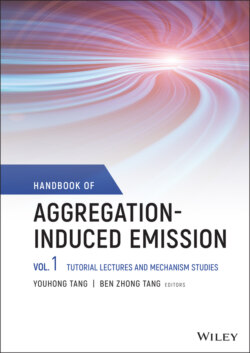Читать книгу Handbook of Aggregation-Induced Emission, Volume 1 - Группа авторов - Страница 44
2.4.5 Pressure‐induced Enhanced Emission (PIEE)
ОглавлениеAs discussed above, the electron–vibration and vibration–vibration couplings are sensitive to molecular packing. If so, they are sure to further decouple to larger extent under external pressure because of the more densely molecular packing and then enhancing the solid‐phase fluorescent emission, called pressure‐induced emission enhancement (PIEE) [71–73]. Take HPS [37] as an example; the mechanism behind PIEE was studied by combining DFT‐D crystalline‐structure simulations, QM/MM, and TVCF formalism [74]. It is found that upon compression, the volume is continuously reduced, and the intermolecular C–H…π hydrogen bond, steric hindrance, and π–π interactions are increased accordingly. The torsional motions of phenyl rings at the 2,5‐positions are firstly hindered from 5.06 to 10.86 GPa and then slightly active as pressure increases. As expected, with the increase of the pressure, the reorganization energy λg(e) is gradually decreased until it reaches a saturation value, while the intermolecular excitonic coupling (J) changes a little, and it is very small and would have no effect on the optical properties; see Figure 2.9a. More excitedly, the kic is expected to reduce quickly first when pressure increases from 0 to 5.06 GPa and then levels off beyond 5.06 GPa, as shown in Figure 2.9b. As expected, the kr of HPS is insensitive to pressure because it is not mainly controlled by the reorganization energy [13]. Accordingly, ΦF rises rapidly with pressure up to 5.06 GPa but tends to level off at higher pressures. The calculated results are well consistent with the experiments [71]. Overall, the PIEE fully supports the origin of the AIE mechanism proposed above.
Figure 2.9 (a) Reorganization energies λg(e) and excitonic couplings J of HPS in aggregates at different pressures. (b) Calculated kic and ΦF of HPS in aggregates at different pressures.
Source: Reproduced from Ref. [74]. Copyright 2018 The Royal Society of Chemistry.
